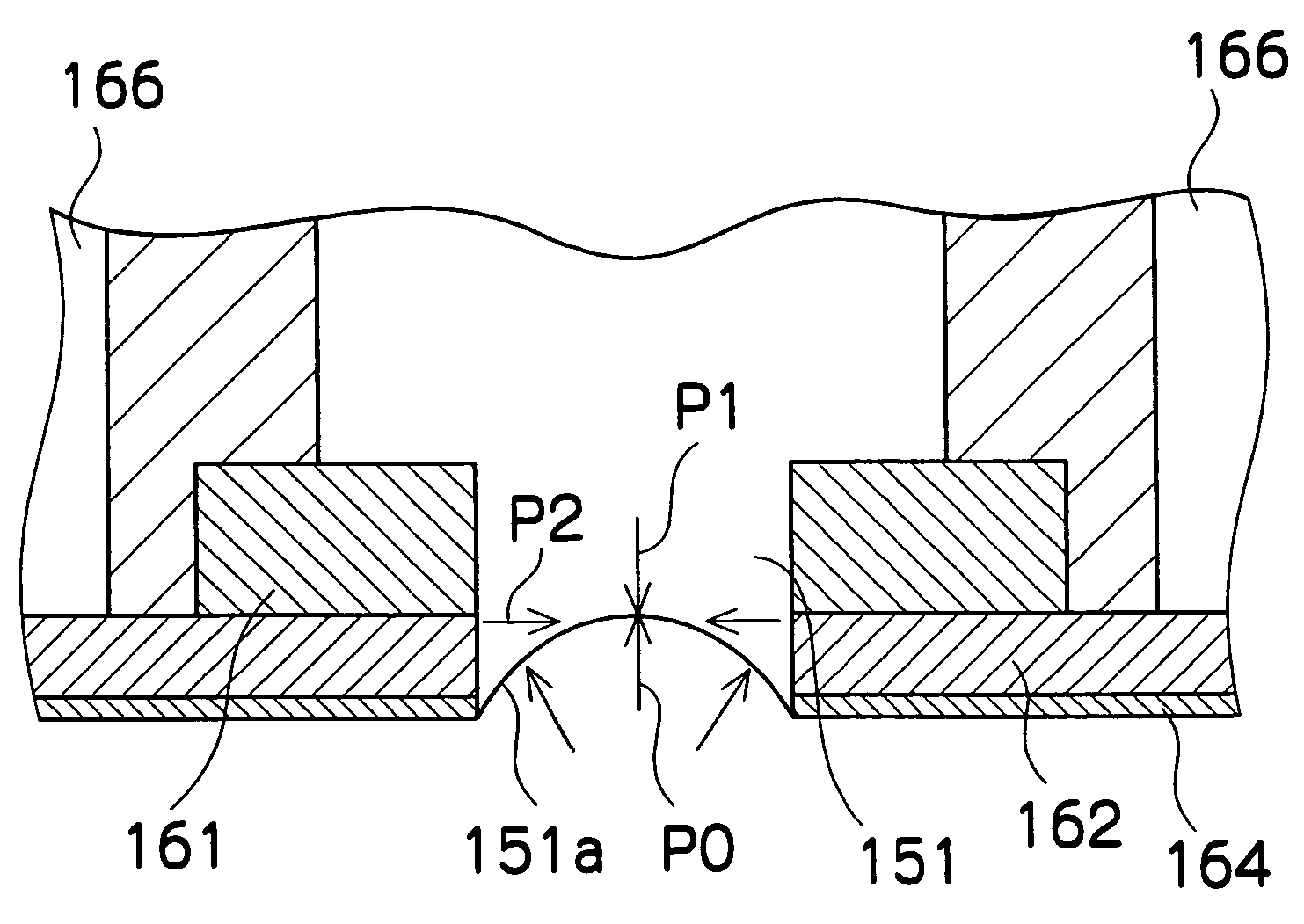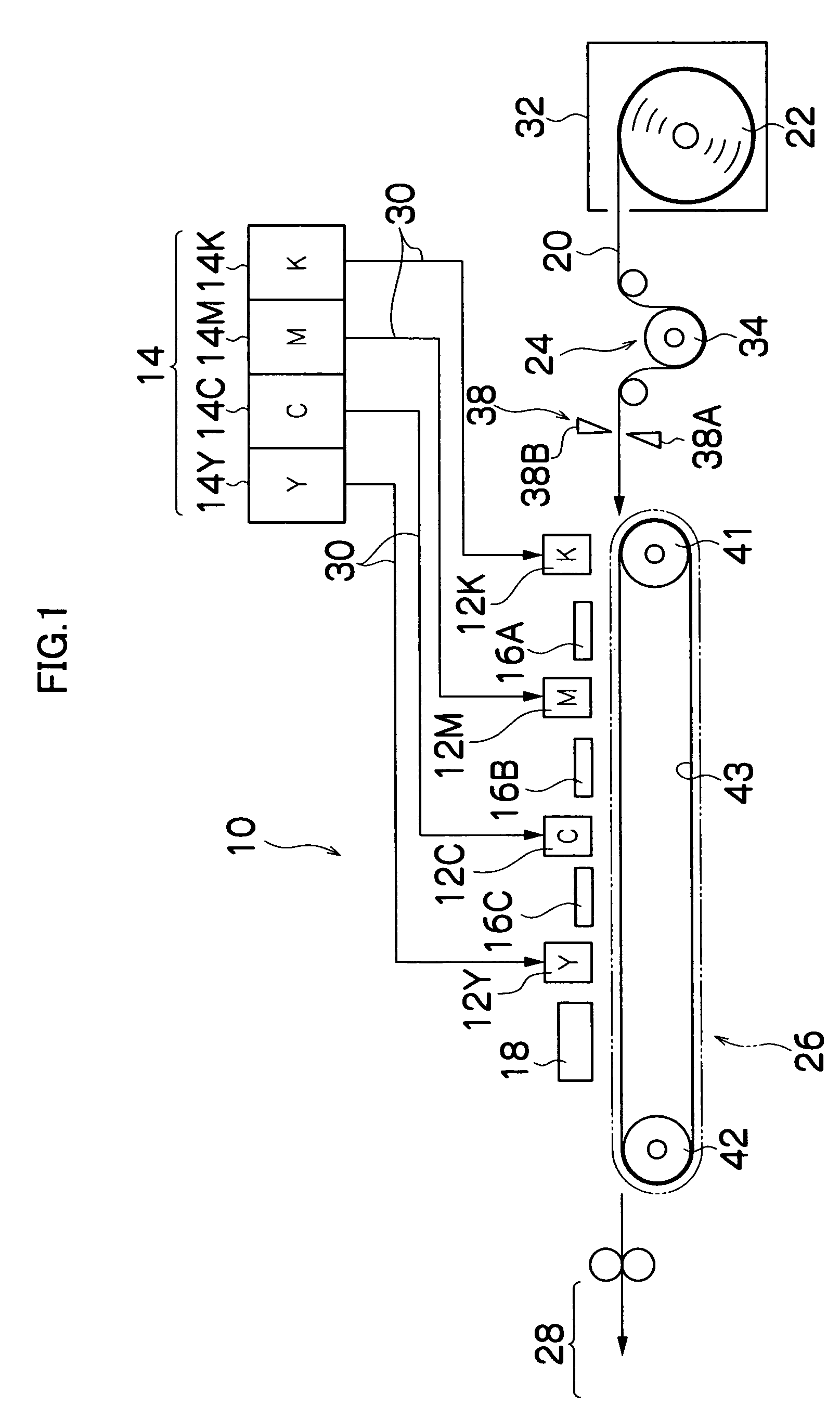Inkjet recording head and inkjet recording apparatus
a recording head and inkjet technology, applied in the direction of printing, other printing apparatus, etc., can solve the problems of difficult to achieve ink discharge, long drying time of ink, and deterioration of printed image quality, so as to prevent the occurrence of nozzle blockage and prevent the increase in the viscosity of ink at the meniscus surfa
- Summary
- Abstract
- Description
- Claims
- Application Information
AI Technical Summary
Benefits of technology
Problems solved by technology
Method used
Image
Examples
second embodiment
[0107]FIGS. 7A and 7B show the relationship among the ink discharged from a nozzle 51, the sealing liquid 60, and the irradiation position by the ultraviolet irradiating unit 16 in a second embodiment of the present invention. More specifically, FIG. 7A shows a case during ink discharge, and FIG. 7B shows a case during irradiation of ultraviolet light. As shown in FIGS. 7A and 7B, this second embodiment differs from the first embodiment described above in that the ultraviolet irradiating unit 16 irradiates ultraviolet light to the ink after the ink has adhered to the print surface of the record paper 20. The other compositions are the substantially same as those of the first embodiment.
[0108]As shown in FIG. 7A, the ultraviolet irradiating unit 16 is disposed at the position adjacent to the print head 50 in such a manner that the ultraviolet irradiating unit 16 irradiates ultraviolet light onto the record paper 20 in line with the print head 50. As shown in FIG. 7B, when an ink drop...
third embodiment
[0111]FIGS. 8A and 8B show the relationship among the ink discharged from the nozzle 51, the sealing liquid 60, and the irradiation position by the ultraviolet irradiating unit 16 in a third embodiment of the present invention. More specifically, FIG. 8A shows a case where ultraviolet light is irradiated onto an ink droplet in flight, and FIG. 8B shows a case where ultraviolet light is irradiated onto an ink droplet on the record paper.
[0112]As shown in FIGS. 8A and 8B, in this third embodiment, the inkjet recording apparatus 10 comprises a signal control device 70 that controls the irradiation of ultraviolet light onto the ink droplets by the ultraviolet irradiating units 16, in such a manner that the irradiation is performed in synchronism with the discharge of the ink from the nozzles 51. FIG. 8A corresponds to the first embodiment described above and shows a case where ultraviolet light is irradiated onto the ink droplets in flight, and FIG. 8B corresponds to the second embodime...
fourth embodiment
[0117]FIG. 9 is a general compositional diagram of an inkjet recording apparatus according to a fourth embodiment of the present invention. As shown in FIG. 9, this inkjet recording apparatus 110 comprises a print unit 112 having a plurality of print heads 112K, 112C, 112M, 112Y provided corresponding to respective ink colors; an ink storing and loading unit 114 for storing ink to be supplied to the print heads 112K, 112C, 112M and 112Y; a paper supply unit 118 for supplying record paper 116; a decurling unit 120 for removing curl in the record paper 116; a suction belt conveyance unit 122, disposed facing the nozzle face (ink discharge face) of the print unit 112, for conveying the record paper 116 while keeping the record paper 116 flat; a print determination unit 124 for reading in the print results; and a paper output unit 126 for outputting the recorded record paper (printed matter) to the exterior.
[0118]In FIG. 9, a single magazine for rolled paper (continuous paper) is shown ...
PUM
 Login to View More
Login to View More Abstract
Description
Claims
Application Information
 Login to View More
Login to View More - R&D
- Intellectual Property
- Life Sciences
- Materials
- Tech Scout
- Unparalleled Data Quality
- Higher Quality Content
- 60% Fewer Hallucinations
Browse by: Latest US Patents, China's latest patents, Technical Efficacy Thesaurus, Application Domain, Technology Topic, Popular Technical Reports.
© 2025 PatSnap. All rights reserved.Legal|Privacy policy|Modern Slavery Act Transparency Statement|Sitemap|About US| Contact US: help@patsnap.com



